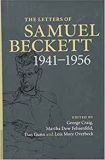The Letters of Samuel Beckett: Volume 2, 1941-1956 by Samuel Beckett, Martha Dow Fehsenfeld, Lois More Overbeck, George Craig and Dan Gunn
| The Letters of Samuel Beckett: Volume 2, 1941-1956 by Samuel Beckett, Martha Dow Fehsenfeld, Lois More Overbeck, George Craig and Dan Gunn | |
|
| |
| Category: Autobiography | |
| Reviewer: John Van der Kiste | |
| Summary: The second of a planned series of four volumes of the Irish playwright's correspondence, which despite the slightly misleading title covers the post-war years. | |
| Buy? Maybe | Borrow? Yes |
| Pages: 886 | Date: September 2011 |
| Publisher: Cambridge University Press | |
| ISBN: 978-0521867948 | |
|
| |
The letters of Samuel Beckett, covering the years 1929 to his death in 1989, are currently being edited in four volumes. Volume 1, 1929-40, was published in 2009.
Despite the title, Volume 2 really begins in 1945. During the war, Beckett was working with the French Resistance, and had to go into hiding. In order to keep the picture reasonably complete, there is a chronology of the war years, and the introduction includes a lettercard sent to James Joyce in February 1941, a pre-printed postcard presenting prefabricated phrases which the sender could strike out as appropriate. During the war only the mildest of family news could be sent through the mail, and even this was subject to censorship. Joyce never received the card, as he died the day after it was written.
The correspondence therefore starts in January 1945. Many of the letters were originally written in French, although George Craig later translated them into English. These years cover the period of his major achievements, notably a series of novels and Waiting for Godot, the play for which he is most remembered.
Ever the most reclusive of characters, he always shunned the limelight. A letter of 1951 from his lover and later wife Suzanne Dumesnil to his publisher says apologetically that he will not hear of being interviewed, either orally or in writing. Like many another writer, he valued his privacy, happy to let his writing say everything he wanted to without the need to explain it. He declares himself incapable of writing even a brief piece for the Radio Times; my ideas about radio are not even quarter baked and to write about my own work is a thing I simply can't do. Much of his surplus energy was expended in liaising with publishers and producers, to ensure that his work was conveyed in the way he wished. There are flashes of occasional unworldliness, for example in a comment from a letter of January 1956 to theatre director Alan Schneider on the principle that success and failure on the public level never mattered much to him; in fact I feel much more at home with the latter, having breathed deep of its vivifying air all my writing life up to the last couple of years.
There are charming glimpses of his love of nature and the environment, and expressions of annoyance; Why are there larks to nest in the fields of clover which are already being cut, when they could be undisturbed in the corn for months yet? When he was not writing, he seems to have been kept happy and busy in the garden, as he talks enthusiastically about planting sycamore, red hawthorn, cedar of Lebanon, and proclaims that he knows all about couch grass and the fearsome bindweed, and the way to get the dandelion with its root. Yet he is in two minds about his peaceful surroundings off the beaten track, as when he is at home at Seine-et-Marne, I never want to leave the place and when in Paris wish I was rid of it.
In addition to the letters themselves, there are introductions on his life during the war, his increasing familiarisation with the French language, year-by-year chronologies, and profiles of his correspondents.
Anybody unfamiliar with the life of writings of Beckett would be well advised to go for a biography of the man first. But for anyone who wishes to go beyond that stage, this generous volume will prove a very full and rewarding read.
Our thanks to Cambridge University Press for sending Bookbag a copy for review.
For further reading on modern culture of the era, may we also recommend Modernism: The Lure of Heresy - From Baudelaire to Beckett and Beyond by Peter Gay.
Please share on: ![]() Facebook,
Facebook, ![]() Twitter and
Twitter and
![]() Instagram
Instagram
![]() You can read more book reviews or buy The Letters of Samuel Beckett: Volume 2, 1941-1956 by Samuel Beckett, Martha Dow Fehsenfeld, Lois More Overbeck, George Craig and Dan Gunn at Amazon.co.uk Amazon currently charges £2.99 for standard delivery for orders under £20, over which delivery is free.
You can read more book reviews or buy The Letters of Samuel Beckett: Volume 2, 1941-1956 by Samuel Beckett, Martha Dow Fehsenfeld, Lois More Overbeck, George Craig and Dan Gunn at Amazon.co.uk Amazon currently charges £2.99 for standard delivery for orders under £20, over which delivery is free.
![]() You can read more book reviews or buy The Letters of Samuel Beckett: Volume 2, 1941-1956 by Samuel Beckett, Martha Dow Fehsenfeld, Lois More Overbeck, George Craig and Dan Gunn at Amazon.com.
You can read more book reviews or buy The Letters of Samuel Beckett: Volume 2, 1941-1956 by Samuel Beckett, Martha Dow Fehsenfeld, Lois More Overbeck, George Craig and Dan Gunn at Amazon.com.
Comments
Like to comment on this review?
Just send us an email and we'll put the best up on the site.


